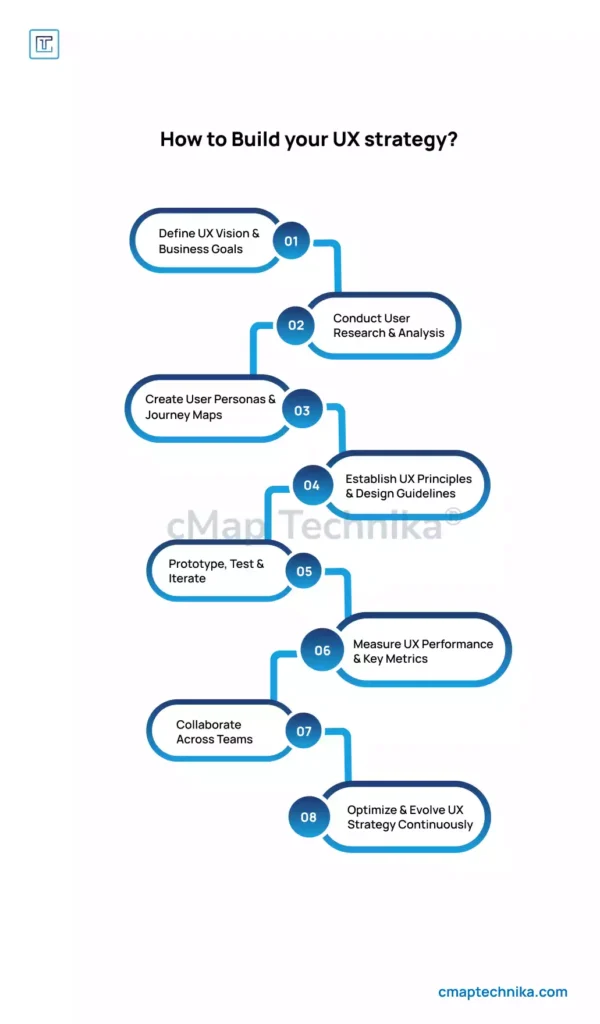User experience (UX) design is often associated with aesthetics—beautiful interfaces, smooth navigation, and visually appealing elements. While these factors are important, truly effective UX design goes beyond just looks. It is about creating seamless, intuitive experiences that serve the core objectives of the business, drive user engagement, and contribute to long-term success.
When UX design is aligned with strategic business goals, it becomes a powerful tool for achieving broader organizational objectives. At Waltcorp, we believe that integrating UX design into your company’s vision isn’t just about making things look good—it’s about enhancing functionality, improving customer satisfaction, and ultimately driving growth.
In this article, we’ll explore how effective UX design aligns with strategic business goals and how it can be leveraged to improve organizational performance, increase conversion rates, and ensure a strong market position.
Understanding UX Design and Its Role in Business Strategy

UX design encompasses the entire process of creating products that provide meaningful and relevant experiences for users. It involves every aspect of interaction with a product, from its design and usability to the overall functionality and user satisfaction.
However, when UX is aligned with business goals, it transcends simple design. It becomes a strategic asset that supports business objectives, whether that’s increasing customer retention, driving sales, enhancing brand loyalty, or improving customer service. UX design can influence key performance indicators (KPIs) such as user engagement, conversion rates, and customer satisfaction—metrics that are directly tied to business success.
The Strategic Importance of UX Design
Here’s how aligning UX design with business goals can lead to tangible benefits:

1. Improved User Retention and Loyalty
In today’s competitive market, retaining users is just as important, if not more so, than acquiring them. When a product or service is intuitive, easy to navigate, and meets the needs of the user, it builds trust and enhances user satisfaction. A great user experience makes users feel valued, encouraging them to return and engage more frequently.
By aligning UX design with business goals, organizations can create experiences that foster loyalty. This may include personalized interfaces, simplified workflows, and intuitive interactions that encourage users to continue using the service or product. A seamless experience that’s in tune with user needs not only keeps them coming back, but also turns them into brand advocates.
2. Increased Conversion Rates
UX design plays a critical role in conversion optimization. Whether it’s completing a purchase, filling out a form, or subscribing to a service, the design of a product or website can significantly impact how users engage with calls to action (CTAs) and complete desired actions.
By focusing on business goals such as improving sales or generating leads, UX design can be fine-tuned to guide users seamlessly toward these outcomes. Effective design reduces friction points in the user journey—such as confusing navigation, slow loading times, or unnecessary steps in the process—resulting in higher conversion rates and a better return on investment (ROI).
3. Better Alignment with Customer Needs
One of the most important aspects of UX design is its ability to align with the needs of users. Businesses that invest in understanding their customers through research, data analysis, and feedback loops are able to create experiences that directly meet user expectations.
When UX design is aligned with these insights, it creates more than just a product—it creates a solution. By identifying and addressing user pain points, businesses can deliver a more satisfying and impactful experience. This focus on user-centric design leads to better customer retention, satisfaction, and overall success in meeting the organization’s goals.
4. Enhanced Brand Perception
UX design is often a direct reflection of the company’s values and brand identity. A product with poor UX design can give off the impression that the company doesn’t value its customers’ time or needs, leading to negative perceptions of the brand. Conversely, a well-designed product or service that prioritizes user experience strengthens brand credibility, trustworthiness, and professionalism.
Aligning UX design with business goals ensures that the design not only meets functional needs but also represents the brand’s core values. Whether it’s through consistency in design elements, a focus on customer-first service, or clear communication, great UX design helps businesses establish and enhance their brand identity in the eyes of users.
5. Efficient Resource Utilization
When UX design aligns with business objectives, it helps organizations make the best use of resources—whether that’s time, money, or talent. A UX design strategy that focuses on the business’s goals ensures that resources are directed toward elements that will drive results, whether it’s enhancing a product feature, simplifying a process, or improving accessibility.
This leads to smarter decision-making about where to invest in design improvements and how to allocate resources effectively. By addressing key business challenges through design, companies can optimize the impact of their investments.
Aligning UX Design with Strategic Business Goals
To fully leverage the power of UX design in driving business success, it must be strategically aligned with the company’s vision and objectives. Here are some best practices for ensuring that your UX design supports your business goals:

1. Conduct Comprehensive User Research
User research is the foundation of user-centric design. By understanding who your users are, what their pain points are, and what they need, you can create designs that are not only visually appealing but also highly functional. This research ensures that design decisions are grounded in real user insights, rather than assumptions.
2. Define Clear Business Objectives
Before embarking on the design process, it’s essential to define your business objectives clearly. Are you trying to increase sales, improve customer retention, reduce churn, or streamline operations? Having well-defined goals ensures that UX design decisions are made with a specific business outcome in mind.
3. Collaborate Across Teams
Design doesn’t happen in a vacuum. Collaboration between cross-functional teams—such as product managers, developers, marketers, and customer support teams—ensures that UX design is fully aligned with the company’s objectives. This collaborative approach helps create a cohesive strategy where design decisions are made with input from various departments.
4. Iterate and Test Continuously
The user experience is never “finished.” It requires continuous testing, iteration, and refinement. By conducting usability tests and gathering user feedback at various stages of the design process, businesses can ensure that the design evolves in a way that best supports business goals. Agile methodologies are particularly effective here, as they allow for flexibility and ongoing adjustments based on user insights.
5. Measure UX Success with Business Metrics
The ultimate goal of UX design is to drive business success. To evaluate how well UX is aligned with business goals, it’s important to track key performance indicators (KPIs) such as user engagement, conversion rates, customer retention, and revenue growth. By measuring UX performance against these business metrics, organizations can assess the impact of design decisions and make data-driven improvements.
Conclusion
Effective UX design is more than just aesthetics—it’s about creating a seamless, intuitive experience that aligns with your company’s core objectives and vision. When UX is strategically integrated into business goals, it becomes a powerful tool for improving customer satisfaction, increasing conversions, and enhancing brand perception.
At Waltcorp, we understand that UX design must be driven by empathy, user insights, and a clear business strategy. By prioritizing these elements, businesses can create user-centered designs that not only look great but also deliver real results. In today’s competitive landscape, aligning UX design with strategic business goals is no longer a luxury—it’s a necessity for long-term success.






